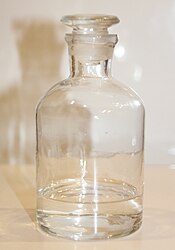
Back رباعي هيدرو الفوران Arabic تتراهیدروفوران AZB টেট্রাহাইড্রোফিউরান Bengali/Bangla Tetrahidrofuran Catalan Tetrahydrofuran Czech Tetrahydrofuran German Τετραϋδροφουράνιο Greek Kvarhidrofurano Esperanto Tetrahidrofurano Spanish Tetrahüdrofuraan Estonian
| |||

| |||
| Names | |||
|---|---|---|---|
| Preferred IUPAC name
Oxolane[1] | |||
| Systematic IUPAC name
1,4-Epoxybutane 1-Oxacyclopentane | |||
| Other names
Tetrahydrofuran
THF 1,4-Butylene oxide Cyclotetramethylene oxide fraction Furanidin Tetra-methylene oxide, Oxolane | |||
| Identifiers | |||
3D model (JSmol)
|
|||
| Abbreviations | THF | ||
| ChEBI | |||
| ChEMBL | |||
| ChemSpider | |||
| ECHA InfoCard | 100.003.389 | ||
PubChem CID
|
|||
| RTECS number |
| ||
| UNII | |||
CompTox Dashboard (EPA)
|
|||
| |||
| |||
| Properties | |||
| C4H8O | |||
| Molar mass | 72.107 g·mol−1 | ||
| Appearance | Colorless liquid | ||
| Odor | Ether-like[2] | ||
| Density | 0.8876 g/cm3 at 20 °C, liquid [3] | ||
| Melting point | −108.4 °C (−163.1 °F; 164.8 K) | ||
| Boiling point | 66 °C (151 °F; 339 K)[4][3] | ||
| Miscible | |||
| Vapor pressure | 132 mmHg at 20 °C[2] | ||
Refractive index (nD)
|
1.4073 at 20 °C[3] | ||
| Viscosity | 0.48 cP at 25 °C | ||
| Structure | |||
| Envelope | |||
| 1.63 D (gas) | |||
| Hazards | |||
| GHS labelling: | |||
   [5] [5]
| |||
| Danger | |||
| H225, H302, H319, H335, H351[5] | |||
| P210, P280, P301+P312+P330, P305+P351+P338, P370+P378, P403+P235[5] | |||
| NFPA 704 (fire diamond) | |||
| Flash point | −14 °C (7 °F; 259 K) | ||
| Explosive limits | 2–11.8%[2] | ||
| Lethal dose or concentration (LD, LC): | |||
LD50 (median dose)
|
| ||
LC50 (median concentration)
|
21000 ppm (rat, 3 h)[6] | ||
| NIOSH (US health exposure limits): | |||
PEL (Permissible)
|
TWA 200 ppm (590 mg/m3)[2] | ||
REL (Recommended)
|
TWA 200 ppm (590 mg/m3) ST 250 ppm (735 mg/m3)[2] | ||
IDLH (Immediate danger)
|
2000 ppm[2] | ||
| Related compounds | |||
Related heterocycles
|
Furan Pyrrolidine Dioxane | ||
Related compounds
|
Diethyl ether | ||
| Supplementary data page | |||
| Tetrahydrofuran (data page) | |||
Except where otherwise noted, data are given for materials in their standard state (at 25 °C [77 °F], 100 kPa).
| |||
Tetrahydrofuran (THF), or oxolane, is an organic compound with the formula (CH2)4O. The compound is classified as heterocyclic compound, specifically a cyclic ether. It is a colorless, water-miscible organic liquid with low viscosity. It is mainly used as a precursor to polymers.[8] Being polar and having a wide liquid range, THF is a versatile solvent. It is an isomer of another solvent, butanone.
- ^ "New IUPAC Organic Nomenclature - Chemical Information BULLETIN" (PDF).
- ^ a b c d e f NIOSH Pocket Guide to Chemical Hazards. "#0602". National Institute for Occupational Safety and Health (NIOSH).
- ^ a b c Baird, Zachariah Steven; Uusi-Kyyny, Petri; Pokki, Juha-Pekka; Pedegert, Emilie; Alopaeus, Ville (6 Nov 2019). "Vapor Pressures, Densities, and PC-SAFT Parameters for 11 Bio-compounds". International Journal of Thermophysics. 40 (11): 102. Bibcode:2019IJT....40..102B. doi:10.1007/s10765-019-2570-9.
- ^ NIST Chemistry WebBook. http://webbook.nist.gov
- ^ a b c Record of Tetrahydrofuran in the GESTIS Substance Database of the Institute for Occupational Safety and Health, accessed on 2 June 2020.
- ^ a b "Tetrahydrofuran". Immediately Dangerous to Life or Health Concentrations (IDLH). National Institute for Occupational Safety and Health (NIOSH).
- ^ "New Environment Inc. - NFPA Chemicals". Newenv.com. Retrieved 2016-07-16.
- ^ Cite error: The named reference
Ullmannwas invoked but never defined (see the help page).


